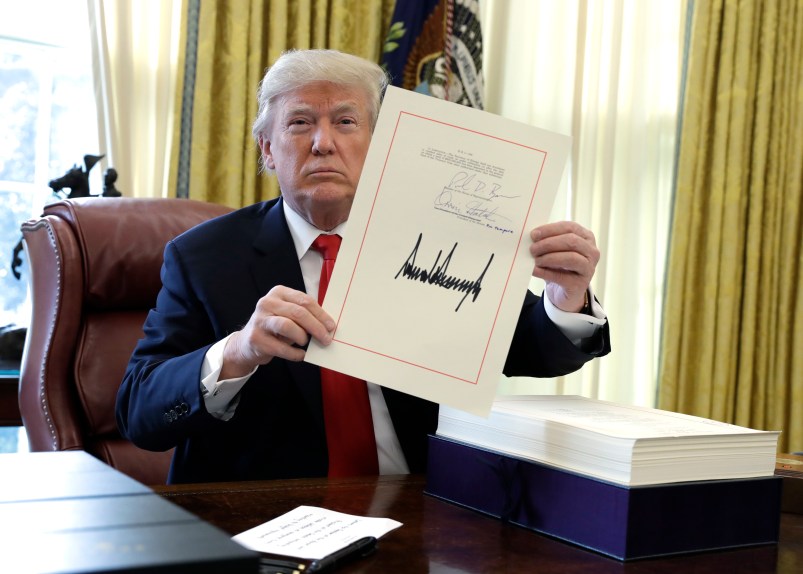WASHINGTON (AP) — President Donald Trump signed the $1.5 trillion tax overhaul into law Friday, using his last moments in the White House before flying to Florida for the holidays to celebrate a much-needed political win.
He also signed a temporary spending bill to keep the government running and provide money to upgrade the nation’s missile defenses. The tax cut, which fulfilled a long-held Republican goal, was at the forefront of Trump’s mind.
Starting next year, the new law will give big cuts to corporation and wealthy Americans and more modest reductions to other families. Trump continued to pitch it as a win a for the middle class, insisting that even though polling indicates the tax cut is unpopular, “the numbers will speak” for themselves.
“I don’t think we are going to have to do much selling,” Trump told reporters in the Oval Office.
The tax law is the largest since 1986, but far from the biggest in American history, as the president repeatedly claims. It also is projected to add to the nation’s debt, something that was anathema to Republicans for years.
Passage of the tax bill marked a significant victory for a president hungry for one after chaos and legislative failures during his first year in office — including an effort to repeal former President Barack Obama’s health care law — despite Republican control of Congress. Trump also ended the year with his sights still trained on the way the media treat him, tweeting that the mainstream media “NEVER talk about our accomplishments in the end of year reviews.”
“We are compiling a long @ beautiful list,” he tweeted.
Trump said that he originally planned to sign the tax bill early next year but moved it up on the spur of the moment after watching media coverage Friday morning about the legislation. After finishing the bill signings, he was off to Mar-a-Lago in Florida, his plane leaving Joint Base Andrews in Maryland just before noon EST.
The first major overhaul of the nation’s tax laws since 1986 could add $1.5 trillion to the national debt over the next decade, according to the Congressional Budget Office. Republican leaders have said they’re willing to take that step in pursuit of a boost to the economy. But some in the GOP worry their party could face a political backlash without an aggressive public relations tour.
Trump, meanwhile, continued to send mixed messages about his desire to work across the aisle. In the Oval Office, he contended anew that Democrats “don’t like tax cuts, they want to raise your taxes.”
But that came just hours after he tweeted a pitch for bipartisanship: “At some point, and for the good of the country, I predict we will start working with the Democrats in a bipartisan fashion. Infrastructure would be a perfect place to start. … It is time to start rebuilding our country!”
Some White House aides and Republican leaders are looking warily ahead at the midterm election year, when typically a president’s party loses seats in Congress. That’s all the more true for presidents whose approval ratings dip below 50 percent, and Trump’s have never been that high.
Additionally, the new tax law that they see as the GOP’s top talking point is unpopular. Only about 1 in 3 voters have supported the legislation in recent days, according to several polls. About half of Americans believe the plan will hurt their personal finances. And 2 in 3 voters say the wealthy will get the most benefits, according to a USA Today/Suffolk University poll released last week.
Starting next year, families making between $50,000 and $75,000 will get average tax cuts of $890, according to an analysis by the nonpartisan Tax Policy Center. Families making between $100,000 and $200,000 would get average tax cuts of $2,260, while families making more than $1 million would get average tax cuts of nearly $70,000, according to the analysis.
But if the cuts for individuals are allowed to expire, most Americans — those making less than $75,000 — would see tax increases in 2027, according to congressional estimates.
Only high-income people would get a meaningful tax cut after 2025, when nearly all of the plan’s individual income tax provisions are due to expire.
Republicans argue that the middle class will see benefits from the business tax cuts, in the form of more jobs and higher wages.
Democrats say that’s not likely to happen, that the tax cuts are simply a boon to wealthy Americans like Trump and leave lower-income families in a lurch.







Trump signs largest middle class increase in a generation into law.
Proving once again that Debt Fears are for suckers. And Democrats. But my Republican’t friends would say I’m being redundant…
Bullshit! He signed it now because Republican’ts added a provision to the bill that keeps the government funded until next month that suspends PAYGO. Had they not done that the PAYGO rules would have triggered automatic cuts to the Social Security, Medicare, Medicaid, the Military and all discretionary spending. But we already know that Trump is a fucking liar…
and just wait until we find out all of the “hidden gems” that are contained in this monstrosity.
Hmmm, and who could the outlier be, perhaps Munchkin’s napkin scribbles - I mean Mnuchin’s in-depth “analysis” - he slipped to the Republicans just prior to the vote, under pressure?
I thought they were holding off signing it until January because it holds mandatory spending cuts that they wanted to put off until after the 2018 Congressional races.
Here’s where I got that, but there are a bunch of stories from yesterday saying it was happening today. https://www.bloomberg.com/news/articles/2017-12-20/trump-is-said-to-plan-tax-signing-jan-3-due-to-technical-issue